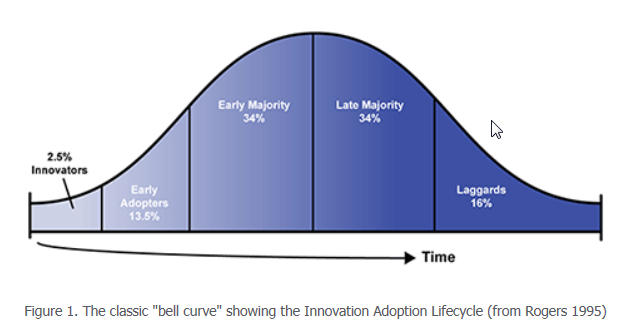Sustainable culture change is difficult.
A common view is that the work required to shift the mindset of any large organization is largely the responsibility of leadership. To be sure, the senior leaders of the organization are accountable for setting the vision and supporting it by what they say and do. Unfortunately, many leaders approach this challenge by delivering a message via well-written power point slides to the masses. The assumption is that all they need to do is explain what the company is about and how everyone should be aligned to be successful. And perhaps for a short while this strategy results in an uptick in the “hoped-for” behaviors.
But it does not last. Soon enough, most of the employees slip back into their comfort zone. They see no reason to change anything. “After all,” they think, “This too shall pass. If I wait long enough, someone else will come along with a different flavor-of-the month. Maybe that one will taste better.”
There are many reasons for failing to get an entire organization aligned and to accept a new way of thinking and acting. I will focus on a single consideration.
We accept change at different rates
Everett Rogers published his theory on the Diffusion of Innovations in 1962. It is a theory that seeks to explain how, why, and at what rate new ideas and technology spread through cultures. The book (now in its fifth edition) says that diffusion is the process by which an innovation is communicated through certain channels over time among the members of a social system. The innovation or idea must be widely adopted in order to self-sustain. Within the rate of adoption, there is a point at which an innovation or idea reaches critical mass. The people in any  social system who are exposed to the new idea can be placed in segments, depending upon their willingness to adopt the new idea or accept change. Rogers named five categories of “adopters” : Innovators, Early Adopters, Early Majority, Late Majority, and Laggards. These categories are depicted in this graphic.
social system who are exposed to the new idea can be placed in segments, depending upon their willingness to adopt the new idea or accept change. Rogers named five categories of “adopters” : Innovators, Early Adopters, Early Majority, Late Majority, and Laggards. These categories are depicted in this graphic.
Don’t try to persuade the majority
Dr. Rogers submits that there is a primary group that you should focus on if you want to get a new idea adopted (or make change happen). And it is NOT the Early Majority or Late Majority – the 2/3 of the population in the center of the adoption curve. Obviously, it is not the “Laggards”. As the name implies, they are the last to accept anything new and will do so only as a last option. But here is the surprising part. It is NOT the “Innovators” either. Even though these people are the first to try something new, they tend to be social outliers who generally do not have strong influence on their peers. Plus, they only make up 2% – 3% of the organization.
Rogers claims that the real power brokers are the “Early Adopters”. These people are also often referred to as “Opinion Leaders”. This group (about 13.5% of the population) is open to new ideas. But the key attribute that makes them valuable as agents of change is that they are respected by a large number of their peers. They are also held in high regard by many people; therefore, they are key links within the network of the organization. It is clear that sustainable change can only happen if the Opinion Leaders can be persuaded to join the cause. If this group can be enlisted, you have the opportunity to reach a tipping point (Malcolm Gladwell’s term) where the rest of the organization will follow their lead and adopt the change.
Opinion Leaders are critical to sustainable continuous improvement
Many authors (including Gladwell and Simon Sinek) have cited Rogers’ work as they talk about what it takes to inspire and lead others through change. The key premise of the diffusion of innovations theory (that Opinion Leaders are a critical group in making change happen) was central to the successful deployment of a large scale multi-site lean six sigma initiative. Three groups of Opinion Leaders were recruited to enable the shift to a continuous improvement mindset:
- Senior Leadership
- Process Champions
- Black Belts
It may seem obvious that the senior leadership of the company needed to be on board to enable a large company-wide deployment of lean six sigma. It wasn’t just that the key senior leaders endorsed LSS. They lived it and demonstrated it. It was manifested in their actions. Here are some examples of those actions:
- Sponsoring a high-profile project with strategic importance
- Asking how we could leverage LSS thinking to obtain a superior outcome
- Interviewing every black belt candidate – and periodically rejecting some because they were not a good fit
- Developing succession plans that gave weighting to those who were LSS certified
- Meeting with every black belt class to hear about their projects and answering their questions
- Personally attending two weeks of Green Belt training to learn the tools and methods
Process Champions were mid-level managers who provided the initial impetus for using LSS to solve some of their most vexing problems. Getting a few of these opinion leaders to be vocal advocates was essential in the early months. There was a bit of faith needed, as the black belts were just learning the LSS tools and methods – but did not have anything tangible for results. Within three months, some of the original projects that were chartered with the Process Champions yielded some impressive savings. This greatly increased the momentum and resulted in more charters being drafted. Some examples of actions from these Opinion Leaders:
- Asking for bi-weekly report outs on progress
- Providing the best available resources to be on LSS teams
- Giving a sponsorship “stump speech” to the team at their kick-off meeting
- Recognizing and celebrating with teams as they completed a successful project
- Setting an expectation for team leadership or participation in the personal goals of their organization.
There was a focused effort to identify and recruit the true Opinion Leaders to serve as Black Belts in the first three or four years. The decision on who would make a great Black Belt candidate was easy. We would approach the site leader or department manager and ask, “Who are the top three people who are most valuable to you – the ones that you would hate to lose as part of your team?” The answer yielded a strong candidate pool. And where did these future Black Belts reside in the organization? They were recruited from roles as department managers, business leaders, senior sales leaders, production managers, superintendents, etc. They all had a minimum of ten years experience and were well regarded. Once these initial recruits were on board, it was clear to the organization that LSS was not a “flavor-of-the-month.” These were some of the most talented employees, who were plucked from promotion-ready positions to spend a 3-year stint as a full-time Black Belt.
As outlined in an earlier post, there are many success factors for an LSS deployment. However, it is not enough to ‘check the box’ on leadership engagement, proactive champions, and full-time black belts. You need to seek out the Opinion Leaders in these three vital groups, who will drive the rest of the organization to the tipping point – and to a sustainable mindset of continuous improvement!
References
Sinek, Simon. (2009). Start With Why. How Great Leaders Inspire Everyone To Take Action. Penguin Group. ISBN 978-1-59184-290-4.
Rogers, Everett M. (1983). Diffusion of Innovations. New York: Free Press. ISBN 978-0-02-926650-2
Gladwell, Malcolm (2002). The Tipping Point: How Little Things Can Make a Big Difference. Little, Brown, and Company. ISBN-13: 978-0-31634-662-7.

